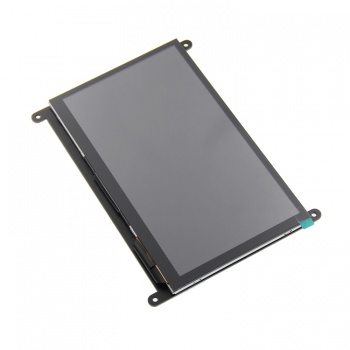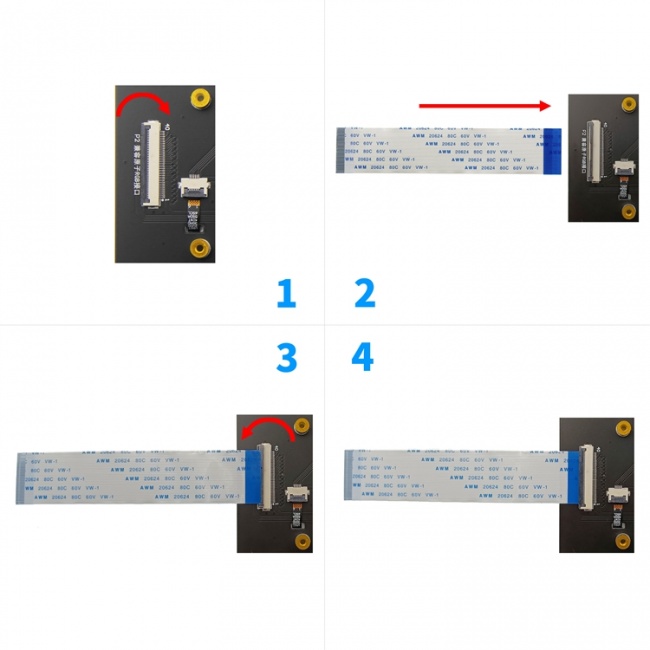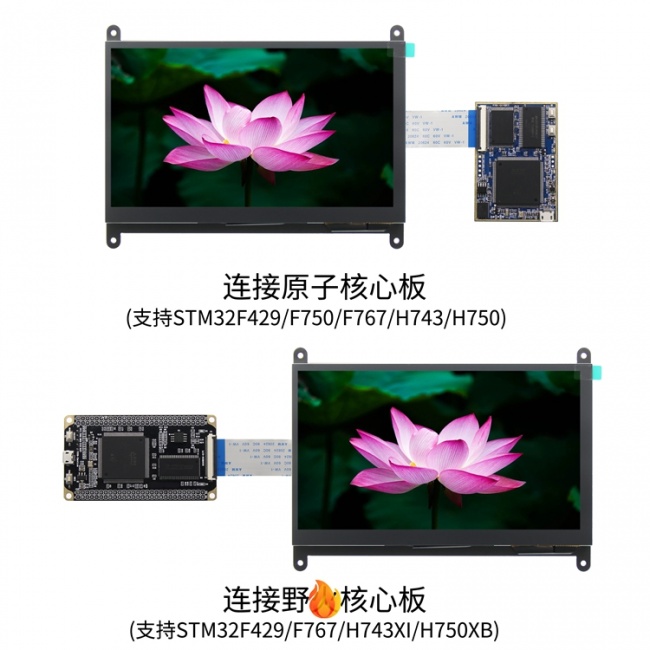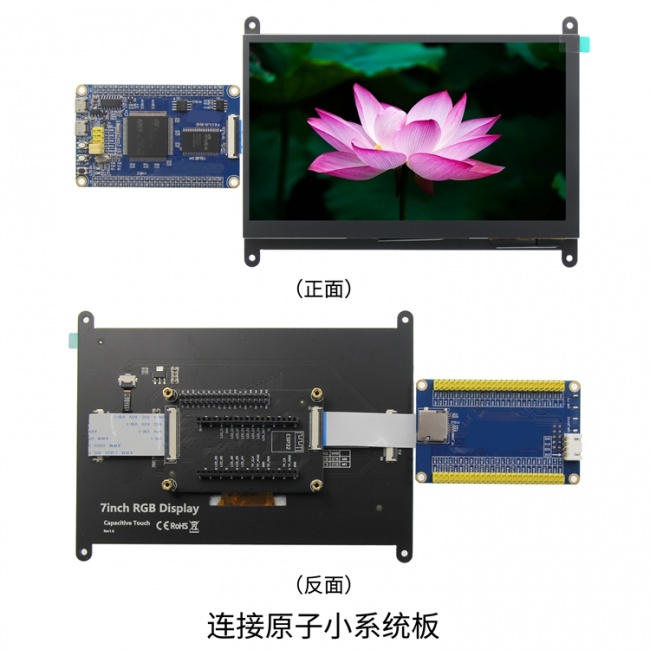More actions
| (25 intermediate revisions by 2 users not shown) | |||
| Line 7: | Line 7: | ||
== <font color="blue">Product Picture</font> == | == <font color="blue">Product Picture</font> == | ||
[[File:7-RGB-5.jpg|350px]] [[File:7-RGB-2pin-修改丝印.jpg|350px]] | |||
==<font color="blue">Product Description</font> == | ==<font color="blue">Product Description</font> == | ||
| Line 15: | Line 16: | ||
* Compatible with RGB interface connection of punctual atomic development board and wildfire development board | * Compatible with RGB interface connection of punctual atomic development board and wildfire development board | ||
* Use capacitive touch screen to support 5 touch points | * Use capacitive touch screen to support 5 touch points | ||
* Provides a rich sample program for STM32 platforms | |||
* Provides a rich sample program for STM32 | |||
* Military-grade process standards, long-term stable work | * Military-grade process standards, long-term stable work | ||
* Provide underlying driver technical support | * Provide underlying driver technical support | ||
| Line 40: | Line 39: | ||
|- | |- | ||
| align="center" |Driver IC | | align="center" |Driver IC | ||
| align="center" |None | | align="center" |None | ||
|- | |- | ||
| align="center" |Resolution | | align="center" |Resolution | ||
| Line 82: | Line 81: | ||
==<font color="blue">Interface Definition</font> == | ==<font color="blue">Interface Definition</font> == | ||
[[File: | [[File:MRG7111_7122-006.jpg|650px]] | ||
:①-- | :①--DITHB selection circuit | ||
:②-- | :②--U/D selection circuit | ||
:③-- | :③--L/R selection circuit | ||
:④--P2 interface (compatible with atomic RGB interface) | :④--Screen resolution selection circuit | ||
: | :⑤--P2 interface (compatible with atomic RGB interface) | ||
:⑥--P3 interface (compatible with wildfire RGB interface) | |||
:⑦--B7 Data line pull resistance (required to define module ID, applicable to atomic program) | |||
'''1. Screen internal Dithering display function settings''' | |||
:Weld the 0 position resistance of DITHB and disconnect the 1 position resistance to enable the internal Dithering display function of the display panel; | |||
:Weld the 1 position resistance of DITHB, disconnect the 0 position resistance, and turn off the internal Dithering display function of the screen; | |||
:Default welding 0 position resistance, disconnect 1 position resistance | |||
'''2. Screen display up and down flip settings''' | |||
'''3. P2 and P3 interface pins are described as follows:''' | :Weld the resistance at position 0 of U / D, disconnect the resistance at position 1, and the screen will turn down; | ||
:Weld the resistance at position 1 of U / D, disconnect the resistance at position 0, and the screen will turn upward; | |||
:Default welding 0 position resistance, disconnect 1 position resistance | |||
'''3. Screen display left and right flip settings''' | |||
:weld the resistance at position 0 of L / R, disconnect the resistance at position 1, and the screen will turn to the left; | |||
:Weld the resistance at position 1 of L / R, disconnect the resistance at position 0, and the screen will turn right; | |||
:Default welding 1 position resistance, disconnect 0 position resistance | |||
'''4. Screen resolution selection''' | |||
:As shown in the screen resolution selection circuit, the module supports screen switching of 800x480 and 1024x600 resolutions. | |||
:Weld M0 resistance to GND, M1 resistance to VCC, select 1024x600 resolution; | |||
:Weld M0 resistance to VCC, M1 resistance to GND, and select 800x480 resolution; | |||
'''5. Precautions for connecting to wildfire development board''' | |||
:'''If connected to wildfire i When using the MX6ULL ARM Linux development board, it is necessary to remove the pull resistance''' | |||
:'''on the B7 data line referred to by label 7 and the M0 and M1 resistance referred to by label 4, otherwise the development board will not run''' | |||
'''6. P2 and P3 interface pins are described as follows:''' | |||
*'''P2 interface (compatible with atomic RGB interface) pin description''' | *'''P2 interface (compatible with atomic RGB interface) pin description''' | ||
| Line 194: | Line 211: | ||
*'''P3 interface (compatible with wildfire RGB interface) pin description''' | *'''P3 interface (compatible with wildfire RGB interface) pin description''' | ||
{| class="wikitable" border="1" style="width: 700px; background-color: white;" | {| class="wikitable" border="1" style="width: 700px; background-color: white;" | ||
|- | |- | ||
| align="center" |Number | | align="center" |Number | ||
| Line 201: | Line 218: | ||
|- | |- | ||
| align="center" |1 | | align="center" |1 | ||
| align="center" | | | align="center" |VCC5 | ||
| | |Power input pin(connect to 5V) | ||
|- | |- | ||
| align="center" |2 | | align="center" |2 | ||
| align="center" | | | align="center" |VCC5 | ||
| | |Power input pin(connect to 5V) | ||
|- | |- | ||
| align="center" |3 | | align="center" |3 | ||
| align="center" | | | align="center" |VCC3.3 | ||
| | |Power input pin(connect to 3.3V) | ||
|- | |- | ||
| align="center" |4 | | align="center" |4 | ||
| align="center" | | | align="center" |VCC3.3 | ||
| | |Power input pin(connect to 3.3V) | ||
|- | |- | ||
| align="center" |5 | | align="center" |5 | ||
| Line 220: | Line 237: | ||
|power ground pin | |power ground pin | ||
|- | |- | ||
| align="center" |6 | | align="center" |6~13 | ||
| align="center" | | | align="center" |R0 ~ R7 | ||
| | |8-bit RED data pin | ||
|- | |||
| align="center" |14~21 | |||
| align="center" |G0 ~ G7 | |||
|8-bit GREEN data pin | |||
|- | |- | ||
| align="center" | | | align="center" |22~29 | ||
| align="center" | | | align="center" |B0 ~ B7 | ||
| | |8-bit BLUE data pin | ||
|- | |- | ||
| align="center" | | | align="center" |30 | ||
| align="center" | | | align="center" |PCLK | ||
| | |Pixel clock control pin | ||
|- | |- | ||
| align="center" | | | align="center" |31 | ||
| align="center" |HSYNC | | align="center" |HSYNC | ||
|Horizontal synchronous signal control pin | |Horizontal synchronous signal control pin | ||
|- | |- | ||
| align="center" | | | align="center" |32 | ||
| align="center" |VSYNC | | align="center" |VSYNC | ||
|Vertical synchronous signal control pin | |Vertical synchronous signal control pin | ||
|- | |- | ||
| align="center" | | | align="center" |33 | ||
| align="center" | | | align="center" |DE | ||
| | |Data enable signal control pin | ||
|- | |- | ||
| align="center" | | | align="center" |34 | ||
| align="center" | | | align="center" |DISP | ||
| | |LCD display enable pin (enable at high level, the module is not used) | ||
|- | |- | ||
| align="center" | | | align="center" |35 | ||
| align="center" |BL | |||
|LCD backlight control pin | |||
| align="center" | | |||
| | |||
|- | |- | ||
| align="center" |36 | | align="center" |36 | ||
| Line 261: | Line 278: | ||
|- | |- | ||
| align="center" |37 | | align="center" |37 | ||
| align="center" | | | align="center" |TP_RST | ||
| | |Capacitor touch screen reset pin(enable at low level) | ||
|- | |- | ||
| align="center" |38 | | align="center" |38 | ||
| align="center" | | | align="center" |TP_PEN | ||
| | |Touch screen interrupt control pin (low level when touch is generated) | ||
|- | |- | ||
| align="center" |39 | | align="center" |39 | ||
| align="center" | | | align="center" |TP_SDA | ||
| | |Data pin of IIC bus of capacitance touch screen | ||
|- | |- | ||
| align="center" |40 | | align="center" |40 | ||
| align="center" | | | align="center" |TP_SCL | ||
| | |IIC bus clock control pin of capacitive touch screen | ||
|- | |- | ||
|} | |} | ||
==<font color="blue">How to connect the development board</font> == | ==<font color="blue">How to connect the development board</font> == | ||
[[File:5-RGB-连接-40pin.jpg|650px]] | |||
[[File:7-RGB-连接.jpg|650px]] | |||
[[File:7-RGB-连接-原子小系统板.jpg|650px]] | |||
[[File:7-RGB-转接板-STM32F407-2.jpg|650px]] | |||
[[File:7-RGB-ESP32-2.jpg|650px]] | |||
==<font color="blue">Program Download</font> == | ==<font color="blue">Program Download</font> == | ||
* [http://www.lcdwiki.com/res/Program/ | * [http://www.lcdwiki.com/res/Program/RGB_LCD/7.0inch/RGB_Display_V1.2/7inch_RGB_Display_V1.2.zip '''7.0inch RGB Display Module package'''] | ||
==<font color="blue">Product Documentation</font> == | ==<font color="blue">Product Documentation</font> == | ||
* [http://www.lcdwiki.com/res/ | * [http://www.lcdwiki.com/res/MRG7111_7122/7.0inch_RGB_Display_User_Manual_EN.pdf '''7.0inch RGB Display Module User Manual'''] | ||
* [http://www.lcdwiki.com/res/ | * [http://www.lcdwiki.com/res/MRG7111_7122/7.0inch_IPS_3.5100_BOE_Specification.pdf ''' 7.0inch RGB IPS TFTLCD Specification'''] | ||
* [http://www.lcdwiki.com/zh/images/ | * [http://www.lcdwiki.com/res/MRG7111_7122/7.0inch_TN_3.5-100_BOE_Specification.pdf ''' 7.0inch RGB TN TFTLCD Specification'''] | ||
* [http://www.lcdwiki.com/res/ | * [http://www.lcdwiki.com/res/MRG7111_7122/7.0inch_IPS_RGB_Timing_1024x600.pdf '''7.0inch RGB IPS TFTLCD RGB Timing'''] | ||
* [http://www.lcdwiki.com/res/ | * [http://www.lcdwiki.com/res/MRG7111_7122/7.0inch_TN_RGB_Timing_800x480.pdf '''7.0inch RGB TN TFTLCD RGB Timing'''] | ||
* [http://www.lcdwiki.com/res/ | * [http://www.lcdwiki.com/zh/images/b/b0/MRG7111_7122-001.jpg '''7.0inch RGB Display Module Size Picture'''] | ||
* [http://www.lcdwiki.com/res/ | * [http://www.lcdwiki.com/res/MRG7111_7122/7inch_RGB_display_Schematic.pdf '''7.0inch RGB Display Module Schematic'''] | ||
* [http://www.lcdwiki.com/res/ | * [http://www.lcdwiki.com/res/MRG7111_7122/Altium_Package_Library.zip '''7.0inch RGB Display Module TFTLCD Schematic and PCB Package Library'''] | ||
* [http://www.lcdwiki.com/res/ | * [http://www.lcdwiki.com/res/MRG7111_7122/HX8282-A11_DS_v01.pdf '''7.0inch RGB IPS display driver IC data manual HX8282-A11'''] | ||
* [http://www.lcdwiki.com/res/MRG7111_7122/EK9716B_DS_rev1.5.pdf '''7.0inch RGB TN display driver IC data manual EK9716B'''] | |||
* [http://www.lcdwiki.com/res/MRG7111_7122/FT5x26-Datasheet(V01).pdf '''Capacitance touch IC FT5426 Data sheet'''] | |||
* [http://www.lcdwiki.com/res/MRG7111_7122/Application_Note_for_CTPM_FocalTech.pdf '''Capacitance touch IC FT5426 Programming Guide'''] | |||
==<font color="blue">Reference Materials</font> == | ==<font color="blue">Reference Materials</font> == | ||
* [http://www.lcdwiki.com/res/PublicFile/STM32_Keil_Use_Illustration_EN.pdf '''STM32 keil software use illustration'''] | * [http://www.lcdwiki.com/res/PublicFile/STM32_Keil_Use_Illustration_EN.pdf '''STM32 keil software use illustration'''] | ||
* [http://www.lcdwiki.com/res/PublicFile/PCtoLCD2002_Use_Illustration_EN.pdf '''PCtoLCD2002 software use illustration'''] | * [http://www.lcdwiki.com/res/PublicFile/PCtoLCD2002_Use_Illustration_EN.pdf '''PCtoLCD2002 software use illustration'''] | ||
* [http://www.lcdwiki.com/res/PublicFile/Image2Lcd_Use_Illustration_EN.pdf '''Image2Lcd software use illustration'''] | * [http://www.lcdwiki.com/res/PublicFile/Image2Lcd_Use_Illustration_EN.pdf '''Image2Lcd software use illustration'''] | ||
Latest revision as of 18:39, 26 October 2023
Product Picture
Product Description
- 7.0-inch color screen, support 24BIT RGB 16.7M color display, display rich colors
- Support 800x480 and 1024x600 resolution screen switching, the display effect is very clear
- Support 24 bit RGB parallel bus transmission
- Compatible with RGB interface connection of punctual atomic development board and wildfire development board
- Use capacitive touch screen to support 5 touch points
- Provides a rich sample program for STM32 platforms
- Military-grade process standards, long-term stable work
- Provide underlying driver technical support
Product Parameters
| Name | Parameter |
| Display Color | RGB888 16.7M (compatible with rgb5665k) color |
| SKU | 800x480:MRG7101(no touch), MRG7111(have touch)
1024x600:MRG7102(no touch),MRG7122(have touch) |
| Screen Size | 7.0(inch) |
| Type | TFT |
| Driver IC | None |
| Resolution | 800*480 or 1024x600 (Pixel) |
| Module Interface | 24Bit RGB parallel interface |
| Touch Screen Type | Capacitive touch screen |
| Touch IC | FT5426 |
| Active Area | 800x480: 153.84x85.63(mm)
1024x600: 154.21x85.92(mm) |
| Module PCB Size | 164.90x124.27(mm) |
| Operating Temperature | -10℃~60℃ |
| Storage Temperature | -20℃~70℃ |
| Input Voltage | 5V |
| IO Voltage | 3.3V |
| Power Consumption | 800x480: 67mA(The backlight is off), 467mA(The backlight is the brightest)
1024x600: 104mA(The backlight is off), 310mA(The backlight is the brightest) |
| Rough Weight(Net weight) | 236(g) |
Interface Definition
- ①--DITHB selection circuit
- ②--U/D selection circuit
- ③--L/R selection circuit
- ④--Screen resolution selection circuit
- ⑤--P2 interface (compatible with atomic RGB interface)
- ⑥--P3 interface (compatible with wildfire RGB interface)
- ⑦--B7 Data line pull resistance (required to define module ID, applicable to atomic program)
1. Screen internal Dithering display function settings
- Weld the 0 position resistance of DITHB and disconnect the 1 position resistance to enable the internal Dithering display function of the display panel;
- Weld the 1 position resistance of DITHB, disconnect the 0 position resistance, and turn off the internal Dithering display function of the screen;
- Default welding 0 position resistance, disconnect 1 position resistance
2. Screen display up and down flip settings
- Weld the resistance at position 0 of U / D, disconnect the resistance at position 1, and the screen will turn down;
- Weld the resistance at position 1 of U / D, disconnect the resistance at position 0, and the screen will turn upward;
- Default welding 0 position resistance, disconnect 1 position resistance
3. Screen display left and right flip settings
- weld the resistance at position 0 of L / R, disconnect the resistance at position 1, and the screen will turn to the left;
- Weld the resistance at position 1 of L / R, disconnect the resistance at position 0, and the screen will turn right;
- Default welding 1 position resistance, disconnect 0 position resistance
4. Screen resolution selection
- As shown in the screen resolution selection circuit, the module supports screen switching of 800x480 and 1024x600 resolutions.
- Weld M0 resistance to GND, M1 resistance to VCC, select 1024x600 resolution;
- Weld M0 resistance to VCC, M1 resistance to GND, and select 800x480 resolution;
5. Precautions for connecting to wildfire development board
- If connected to wildfire i When using the MX6ULL ARM Linux development board, it is necessary to remove the pull resistance
- on the B7 data line referred to by label 7 and the M0 and M1 resistance referred to by label 4, otherwise the development board will not run
6. P2 and P3 interface pins are described as follows:
- P2 interface (compatible with atomic RGB interface) pin description
| Number | Pin name | Description |
| 1 | VCC5 | Power input pin(connect to 5V) |
| 2 | VCC5 | Power input pin(connect to 5V) |
| 3~10 | R0~R7 | 8-bit RED data pin |
| 11 | GND | power ground pin |
| 12~19 | G0 ~ G7 | 8-bit GREEN data pin |
| 20 | GND | power ground pin |
| 21~28 | B0 ~ B7 | 8-bit GREEN data pin |
| 29 | GND | power ground pin |
| 30 | PCLK | Pixel clock control pin |
| 31 | HSYNC | Horizontal synchronous signal control pin |
| 32 | VSYNC | Vertical synchronous signal control pin |
| 33 | DE | Data enable signal control pin |
| 34 | BL | LCD backlight control pin |
| 35 | TP_CS | Capacitor touch screen reset pin (resistance touch screen chip selection pin) |
| 36 | TP_MOSI | Data pin of IIC bus of capacitance touch screen (write data pin of SPI bus of resistance touch screen) |
| 37 | TP_MISO | Resistance touch screen SPI bus read data pin (capacitance touch screen not used) |
| 38 | TP_CLK | IIC bus clock control pin of capacitive touch screen (SPI bus clock control pin of resistance touch screen) |
| 39 | TP_PEN | Touch screen interrupt control pin (low level when touch is generated) |
| 40 | RST | LCD reset control pin (effective at low level) |
- P3 interface (compatible with wildfire RGB interface) pin description
| Number | Pin name | Description |
| 1 | VCC5 | Power input pin(connect to 5V) |
| 2 | VCC5 | Power input pin(connect to 5V) |
| 3 | VCC3.3 | Power input pin(connect to 3.3V) |
| 4 | VCC3.3 | Power input pin(connect to 3.3V) |
| 5 | GND | power ground pin |
| 6~13 | R0 ~ R7 | 8-bit RED data pin |
| 14~21 | G0 ~ G7 | 8-bit GREEN data pin |
| 22~29 | B0 ~ B7 | 8-bit BLUE data pin |
| 30 | PCLK | Pixel clock control pin |
| 31 | HSYNC | Horizontal synchronous signal control pin |
| 32 | VSYNC | Vertical synchronous signal control pin |
| 33 | DE | Data enable signal control pin |
| 34 | DISP | LCD display enable pin (enable at high level, the module is not used) |
| 35 | BL | LCD backlight control pin |
| 36 | GND | power ground pin |
| 37 | TP_RST | Capacitor touch screen reset pin(enable at low level) |
| 38 | TP_PEN | Touch screen interrupt control pin (low level when touch is generated) |
| 39 | TP_SDA | Data pin of IIC bus of capacitance touch screen |
| 40 | TP_SCL | IIC bus clock control pin of capacitive touch screen |
How to connect the development board
Program Download
Product Documentation
- 7.0inch RGB Display Module User Manual
- 7.0inch RGB IPS TFTLCD Specification
- 7.0inch RGB TN TFTLCD Specification
- 7.0inch RGB IPS TFTLCD RGB Timing
- 7.0inch RGB TN TFTLCD RGB Timing
- 7.0inch RGB Display Module Size Picture
- 7.0inch RGB Display Module Schematic
- 7.0inch RGB Display Module TFTLCD Schematic and PCB Package Library
- 7.0inch RGB IPS display driver IC data manual HX8282-A11
- 7.0inch RGB TN display driver IC data manual EK9716B
- Capacitance touch IC FT5426 Data sheet
- Capacitance touch IC FT5426 Programming Guide
Reference Materials
- STM32 keil software use illustration
- PCtoLCD2002 software use illustration
- Image2Lcd software use illustration
- Chinese and English display modulo settings








